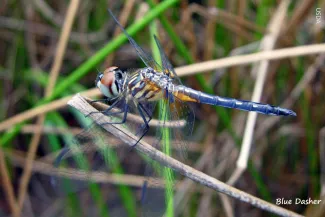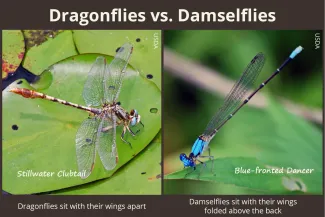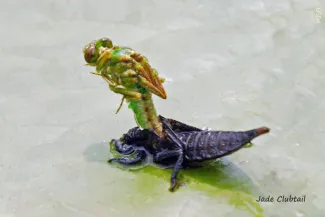Oklahoma’s diversity of dragonflies and damselflies is remarkable; at least 50 species of these relentless hunters of mosquitoes (and a variety of other insects) can be found patrolling in each of our 77 counties. And though they’ve long been part of our natural world, they haven’t always been on the radar of most traditional wildlife watchers.
“It’s been less than 20 years that some of these insects have even had common names,” said Greg Lasley, skilled nature enthusiast and retired law enforcement officer. “Until the year 2000, many were still only known by their scientific name.”

Lasley recently provided a dragonfly and damselfly primer to participants of the Red Slough Birding Convention, where an afternoon tour showcases these flying insects.
Dragonflies and damselflies are small flying insects with a long body, four wings and a strong jaw. “They’re voracious predators and can capture, kill and prey on other insects that may be the same size they are. Many even feed on other dragonflies and damselflies. It’s cold and cruel in the world of insects.”
To tell the two groups of carnivorous insects apart, Lasley offers two tips. “In general, dragonflies sit with their wings apart while damselflies mostly sit with their wings folded above the back. Another distinguishing feature is that the eyes of dragonflies are close together while the eyes of damselflies are well separated and situated on short stalks.”

Regardless of the name or the positioning of the wings, both dragonflies and damselflies are tied to water for a large part of their life. “They lay their eggs in or around water, and the larvae of both have to grow up in water.” Nonbreeding adults can be found miles from a water source.
Throughout their complex life cycle these creatures may molt 8 – 17 times, depending on the species. The final molt is the transformation to an adult dragonfly or damselfly.
“When you see a dragonfly flying around, it’s in the last stage of its life. Many species in temperate states like Texas and Oklahoma only live in this adult stage for three to four weeks. During that time, they’re only focused on eating and breeding.”
Intent on photographing the larvae emerging into this adult form, Lasley once waited more than five hours to watch the process from beginning to end.
“Dragonflies are very soft when they emerge from their larval form, so they typically emerge at night to avoid predation. The larvae will crawl out of the water onto a plant stalk, the back splits open, and the dragonfly pulls its head from the exoskeleton. From there, the wings grow and pulsate as they fill with fluids.”

“When they’ve fully emerged, the adult dragonfly will stay on the plant for another hour, or so, before flying to a tree or other hideout to let their wings harden up for a few days. The ‘wrapper’ or larval exoskeleton will remain on the plant.”
This quest to watch a dragonfly transform from larvae to adult hasn’t been the only time Lasley spent hours in the field watching dragonflies. He often joins scientists and other dragonfly and damselfly enthusiasts searching for species unknown to science and shares his sightings and photographs with crowd-sourced databases like iNaturalist and Odonata Central.
“It’s hard for a layperson to make notable contributions in the well-established bird world, but it’s still possible in the dragonfly world. One to two dragonfly species are being discovered each year. It’s been fun for me to be a part of that.”